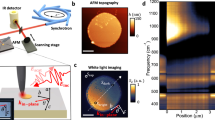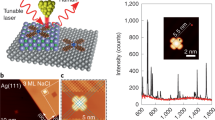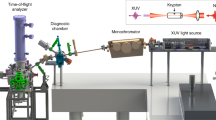Abstract
For decades, infrared (IR) spectroscopy has advanced on two distinct frontiers: enhancing spatial resolution and broadening spectroscopic information. Although atomic force microscopy (AFM)-based IR microscopy overcomes Abbe’s diffraction limit and reaches sub-10 nm spatial resolutions, time-domain two-dimensional IR spectroscopy (2DIR) provides insights into molecular structures, mode coupling and energy transfers. Here we bridge the boundary between these two techniques and develop AFM-2DIR nanospectroscopy. Our method offers the spatial precision of AFM in combination with the rich spectroscopic information provided by 2DIR. This approach mechanically detects the sample’s photothermal responses to a tip-enhanced femtosecond IR pulse sequence and extracts spatially resolved spectroscopic information via FFTs. In a proof-of-principle experiment, we elucidate the anharmonicity of a carbonyl vibrational mode. Further, leveraging the near-field photons’ high momenta from the tip enhancement for phase matching, we photothermally probe hyperbolic phonon polaritons in isotope-enriched h10BN. Our measurements unveil an energy transfer between phonon polaritons and phonons, as well as among different polariton modes, possibly aided by scattering at interfaces. The AFM-2DIR nanospectroscopy enables the in situ investigations of vibrational anharmonicity, coupling and energy transfers in heterogeneous materials and nanostructures, especially suitable for unravelling the relaxation process in two-dimensional materials at IR frequencies.
This is a preview of subscription content, access via your institution
Access options
Access Nature and 54 other Nature Portfolio journals
Get Nature+, our best-value online-access subscription
$29.99 / 30 days
cancel any time
Subscribe to this journal
Receive 12 print issues and online access
$259.00 per year
only $21.58 per issue
Buy this article
- Purchase on Springer Link
- Instant access to full article PDF
Prices may be subject to local taxes which are calculated during checkout





Similar content being viewed by others
Data availability
The data that support the findings of this study are available from the corresponding author upon request. Source data are provided with this paper.
References
Chen, X. et al. Modern scattering‐type scanning near‐field optical microscopy for advanced material research. Adv. Mater. 31, 1804774 (2019).
Hillenbrand, R., Taubner, T. & Keilmann, F. Phonon-enhanced light–matter interaction at the nanometre scale. Nature 418, 159–162 (2002).
Qazilbash, M. M. et al. Mott transition in VO2 revealed by infrared spectroscopy and nano-imaging. Science 318, 1750–1753 (2007).
Mathurin, J. et al. Photothermal AFM-IR spectroscopy and imaging: status, challenges, and trends. J. Appl. Phys. 131, 010901 (2022).
Xie, Q. & Xu, X. G. What do different modes of AFM-IR mean for measuring soft matter surfaces? Langmuir 39, 17593–17599 (2023).
Basov, D. N., Fogler, M. M. & García de Abajo, F. J. Polaritons in van der Waals materials. Science 354, aag1992 (2016).
Dai, S. et al. Tunable phonon polaritons in atomically thin van der Waals crystals of boron nitride. Science 343, 1125–1129 (2014).
Xu, X. G. et al. One-dimensional surface phonon polaritons in boron nitride nanotubes. Nat. Commun. 5, 4782 (2014).
Hu, G. et al. Topological polaritons and photonic magic angles in twisted α-MoO3 bilayers. Nature 582, 209–213 (2020).
Luo, C. et al. Probing polaritons in 2D materials. Adv. Opt. Mater. 8, 1901416 (2020).
Tamagnone, M. et al. Ultra-confined mid-infrared resonant phonon polaritons in van der Waals nanostructures. Sci. Adv. 4, eaat7189 (2018).
Schwartz, J. J., Jakob, D. S. & Centrone, A. A guide to nanoscale IR spectroscopy: resonance enhanced transduction in contact and tapping mode AFM-IR. Chem. Soc. Rev. 51, 5248–5267 (2022).
Wang, L. et al. Revealing phonon polaritons in hexagonal boron nitride by multipulse peak force infrared microscopy. Adv. Opt. Mater. 8, 1901084 (2020).
Hamm, P., Lim, M. & Hochstrasser, R. M. Structure of the amide I band of peptides measured by femtosecond nonlinear-infrared spectroscopy. J. Phys. Chem. B 102, 6123–6138 (1998).
Hamm, P., Lim, M., DeGrado, W. F. & Hochstrasser, R. M. The two-dimensional IR nonlinear spectroscopy of a cyclic penta-peptide in relation to its three-dimensional structure. Proc. Natl Acad. Sci. USA 96, 2036–2041 (1999).
Khalil, M., Demirdöven, N. & Tokmakoff, A. Coherent 2D IR spectroscopy: molecular structure and dynamics in solution. J. Phys. Chem. A 107, 5258–5279 (2003).
Asplund, M. C., Zanni, M. T. & Hochstrasser, R. M. Two-dimensional infrared spectroscopy of peptides by phase-controlled femtosecond vibrational photon echoes. Proc. Natl Acad. Sci. USA 97, 8219–8224 (2000).
Zheng, J., Kwak, K. & Fayer, M. D. Ultrafast 2D IR vibrational echo spectroscopy. Acc. Chem. Res. 40, 75–83 (2007).
Wagner, M. et al. Ultrafast and nanoscale plasmonic phenomena in exfoliated graphene revealed by infrared pump–probe nanoscopy. Nano Lett. 14, 894–900 (2014).
Yao, Z. et al. Nanoimaging and nanospectroscopy of polaritons with time resolved s‐SNOM. Adv. Opt. Mater. 8, 1901042 (2020).
Wagner, M. et al. Ultrafast dynamics of surface plasmons in InAs by time-resolved infrared nanospectroscopy. Nano Lett. 14, 4529–4534 (2014).
Yoxall, E. et al. Direct observation of ultraslow hyperbolic polariton propagation with negative phase velocity. Nat. Photon. 9, 674–678 (2015).
Zhang, X. et al. Ultrafast anisotropic dynamics of hyperbolic nanolight pulse propagation. Sci. Adv. 9, eadi4407 (2023).
Eisele, M. et al. Ultrafast multi-terahertz nano-spectroscopy with sub-cycle temporal resolution. Nat. Photon. 8, 841–845 (2014).
Jiang, T., Kravtsov, V., Tokman, M., Belyanin, A. & Raschke, M. B. Ultrafast coherent nonlinear nanooptics and nanoimaging of graphene. Nat. Nanotechnol. 14, 838–843 (2019).
Wang, L., Wang, H. & Xu, X. G. Principle and applications of peak force infrared microscopy. Chem. Soc. Rev. 51, 5268–5286 (2022).
Schneider, S. H., Kratochvil, H. T., Zanni, M. T. & Boxer, S. G. Solvent-independent anharmonicity for carbonyl oscillators. J. Phys. Chem. B 121, 2331–2338 (2017).
Wang, H., Xie, Q., Zhang, Y. & Xu, X. G. Photothermally probing vibrational excited-state absorption with nanoscale spatial resolution through frequency-domain pump–probe peak force infrared microscopy. J. Phys. Chem. C 125, 8333–8338 (2021).
Caldwell, J. D. et al. Sub-diffractional volume-confined polaritons in the natural hyperbolic material hexagonal boron nitride. Nat. Commun. 5, 5221 (2014).
Li, N. et al. Direct observation of highly confined phonon polaritons in suspended monolayer hexagonal boron nitride. Nat. Mater. 20, 43–48 (2021).
Li, P. et al. Hyperbolic phonon-polaritons in boron nitride for near-field optical imaging and focusing. Nat. Commun. 6, 7507 (2015).
Dai, S. et al. Subdiffractional focusing and guiding of polaritonic rays in a natural hyperbolic material. Nat. Commun. 6, 6963 (2015).
Giles, A. J. et al. Ultralow-loss polaritons in isotopically pure boron nitride. Nat. Mater. 17, 134–139 (2018).
Caldwell, J. D. et al. Photonics with hexagonal boron nitride. Nat. Rev. Mater. 4, 552–567 (2019).
Alfaro-Mozaz, F. J. et al. Hyperspectral nanoimaging of van der Waals polaritonic crystals. Nano Lett. 21, 7109–7115 (2021).
Alfaro-Mozaz, F. J. et al. Nanoimaging of resonating hyperbolic polaritons in linear boron nitride antennas. Nat. Commun. 8, 15624 (2017).
Chaudhary, K. et al. Engineering phonon polaritons in van der Waals heterostructures to enhance in-plane optical anisotropy. Sci. Adv. 5, eaau7171 (2019).
Yang, Y., Finch, M. F., Xiong, D. & Lail, B. A. Hybrid long-range hyperbolic phonon polariton waveguide using hexagonal boron nitride for mid-infrared subwavelength confinement. Opt. Express 26, 26272–26282 (2018).
Autore, M. et al. Boron nitride nanoresonators for phonon-enhanced molecular vibrational spectroscopy at the strong coupling limit. Light Sci. Appl. 7, 17172 (2018).
Klemens, P. G. Anharmonic decay of optical phonons. Phys. Rev. 148, 845–848 (1966).
Srivastava, G. P. The anharmonic phonon decay rate in group-III nitrides. J. Phys. Condens. Matter 21, 174205 (2009).
Cuscó, R. et al. Isotopic effects on phonon anharmonicity in layered van der Waals crystals: isotopically pure hexagonal boron nitride. Phys. Rev. B 97, 155435 (2018).
Ni, G. et al. Long-lived phonon polaritons in hyperbolic materials. Nano Lett. 21, 5767–5773 (2021).
Lee, I.-H. et al. Image polaritons in boron nitride for extreme polariton confinement with low losses. Nat. Commun. 11, 3649 (2020).
Wang, H., Janzen, E., Wang, L., Edgar, J. H. & Xu, X. G. Probing mid-infrared phonon polaritons in the aqueous phase. Nano Lett. 20, 3986–3991 (2020).
Liu, S. et al. Single crystal growth of millimeter-sized monoisotopic hexagonal boron nitride. Chem. Mater. 30, 6222–6225 (2018).
Xie, Q. & Xu, X. G. Fourier-transform atomic force microscope-based photothermal infrared spectroscopy with broadband source. Nano Lett. 22, 9174–9180 (2022).
Hamm, P. & Zanni, M. Concepts and Methods of 2D Infrared Spectroscopy (Cambridge Univ. Press, 2011).
Ruggeri, F. S., Mannini, B., Schmid, R., Vendruscolo, M. & Knowles, T. P. J. Single molecule secondary structure determination of proteins through infrared absorption nanospectroscopy. Nat. Commun. 11, 2945 (2020).
Middleton, C. T., Woys, A. M., Mukherjee, S. S. & Zanni, M. T. Residue-specific structural kinetics of proteins through the union of isotope labeling, mid-IR pulse shaping, and coherent 2D IR spectroscopy. Methods 52, 12–22 (2010).
Shim, S.-H., Strasfeld, D. B., Ling, Y. L. & Zanni, M. T. Automated 2D IR spectroscopy using a mid-IR pulse shaper and application of this technology to the human islet amyloid polypeptide. Proc. Natl Acad. Sci. USA 104, 14197–14202 (2007).
Dolado, I. et al. Remote near-field spectroscopy of vibrational strong coupling between organic molecules and phononic nanoresonators. Nat. Commun. 13, 6850 (2022).
Guo, X. et al. Hyperbolic whispering-gallery phonon polaritons in boron nitride nanotubes. Nat. Nanotechnol. 18, 529–534 (2023).
Ni, G. X. et al. Fundamental limits to graphene plasmonics. Nature 557, 530–533 (2018).
Dery, S. & Gross, E. IR nanospectroscopy in catalysis research. In Ambient Pressure Spectroscopy in Complex Chemical Environments 1396, 147–173 (ACS, 2021).
Acknowledgements
We would like to thank M. T. Zanni, G. C. Walker, J.-H. Jiang and J. T. King for encouragement and consultation on the 2DIR spectroscopy or time-resolved spectroscopy. X.G.X. would like to acknowledge support from the Beckman Young Investigator Award from the Arnold and Mabel Beckman Foundation, the Sloan Research Fellowship from the Alfred P. Sloan Foundation and the Camille Dreyfus Teacher-Scholar Award from the Camille and Henry Dreyfus Foundation. Q.X. and X.G.X. would also like to acknowledge support from the National Science Foundation, award no. CHE 1847765, and Lehigh grant no. COREAWD41. Support for the hBN crystal growth came from the Office of Naval Research, award no. N00014-22-1-2582.
Author information
Authors and Affiliations
Contributions
X.G.X. conceived the design of the AFM-2DIR experiment and instrument. The experimental setup was built by X.G.X. and Q.X. Q.X. carried out the experiment, simulation, data collection and analysis. E.J. and J.H.E. provides the isotope-enriched h10BN for the study. Y.Z. provided assistance on the carbonyl anharmonicity interpretation. The paper was written together by X.G.X. and Q.X. X.G.X. oversaw the research.
Corresponding author
Ethics declarations
Competing interests
The authors declare no competing interests.
Peer review
Peer review information
Nature Nanotechnology thanks Qing Dai and the other, anonymous, reviewer(s) for their contribution to the peer review of this work.
Additional information
Publisher’s note Springer Nature remains neutral with regard to jurisdictional claims in published maps and institutional affiliations.
Supplementary information
Supplementary Information
Supplementary Figs. 1–8 and Note 1.
Source data
41565_2024_1670_MOESM2_ESM.xlsx
Source Data Fig. 2. Raw data for the carbonyl measurements shown in Fig. 2a,c. There are four columns in each dataset: time axis of t1, PFIR photothermal signal, scanned t2-stage location and scanned t1-stage location. After sequential FFTs, the time-domain 2D spectrum should be plotted from the raw data here. Source Data Fig. 4. Raw data for the h10BN AFM-2DIR measurements shown in Fig. 4d,e.
Rights and permissions
Springer Nature or its licensor (e.g. a society or other partner) holds exclusive rights to this article under a publishing agreement with the author(s) or other rightsholder(s); author self-archiving of the accepted manuscript version of this article is solely governed by the terms of such publishing agreement and applicable law.
About this article
Cite this article
Xie, Q., Zhang, Y., Janzen, E. et al. Atomic-force-microscopy-based time-domain two-dimensional infrared nanospectroscopy. Nat. Nanotechnol. (2024). https://doi.org/10.1038/s41565-024-01670-w
Received:
Accepted:
Published:
DOI: https://doi.org/10.1038/s41565-024-01670-w



